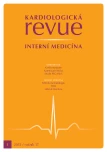Genetics of cardiomyopathies
Authors:
P. Tomašov
Authors‘ workplace:
Kardiologická klinika 2. LF UK a FN v Motole, Praha
Published in:
Kardiol Rev Int Med 2015, 17(1): 15-19
Category:
Cardiology Review
Overview
Cardiomyopathies are a heterogeneous group of diseases with structural and/ or functional myocardial impairment in the absence of ischemic or hemodynamic conditions capable of causing such impairment. Some cardiomyopathies are familial diseases with genetic and phenotypic variability. The heritability of cardiomyopathies became an integral part of new classification schemes of myocardial diseases. Genetic testing is especially beneficial in selected groups of patients and in the management of relatives. New methods of genetic testing will provide diagnosis for more patients and new data regarding genetic variants in patients with cardiomyopathies.
Keywords:
cardiomyopathies – hypertrophic cardiomyopathy – mutation – phenotype – genetic testing
Sources
1. Elliott P, Andersson B, Arbustini E et al. Classification of the cardiomyopathies: a position statement from the European Society of Cardiology Working Group on Myocardial and Pericardial Diseases. Eur Heart J 2008; 29: 270– 276.
2. Perrot A, Dietz R, Osterziel KJ. Is there a common genetic basis for all familial cardiomyopathies? Eur J Heart Fail 2007; 9: 4– 6.
3. Maron BJ, Maron MS. Hypertrophic cardiomyopathy. Lancet 2013; 381: 242– 255. doi: 10.1016/ S0140‑ 6736(12)60397‑ 3.
4. Maron BJ, Gardin JM, Flack JM et al. Prevalence of hypertrophic cardiomyopathy in a general population of young adults. Echocardiographic analysis of 4111 subjects in the CARDIA Study. Coronary Artery Risk Development in (Young) Adults. Circulation 1995; 92: 785– 789.
5. Jarcho JA, McKenna W, Pare JA et al. Mapping a gene for familial hypertrophic cardiomyopathy to chromosome 14q1. N Engl J Med 1989; 321: 1372– 1378.
6. Geisterfer‑ Lowrance AA, Kass S, Tanigawa G et al. A molecular basis for familial hypertrophic cardiomyopathy: a beta cardiac myosin heavy chain gene missense mutation. Cell 1990; 62: 999– 1006.
7. Yingchoncharoen T, Tang WW. Recent advances in hypertrophic cardiomyopathy. F1000Prime Rep 2014; 6: 12. doi: 10.12703/ P6– 12.
8. Binder J, Ommen SR, Gersh BJ et al. Echocardiography‑ guided genetic testing in hypertrophic cardiomyopathy: septal morphological features predict the presence of myofilament mutations. Mayo Clin Proc 2006; 81: 459– 467.
9. Ashrafian H, Watkins H. Reviews of translational medicine and genomics in cardiovascular disease: new disease taxonomy and therapeutic implications cardiomyopathies: therapeutics based on molecular phenotype. J Am Coll Cardiol 2007; 49: 1251– 1264.
10. Coppini R, Ho CY, Ashley E et al. Clinical phenotype and outcome of hypertrophic cardiomyopathy associated with thin‑filament gene mutations. J Am Coll Cardiol 2014; 64: 2589– 2600. doi: 10.1016/ j.jacc.2014.09.059.
11. Burkett EL, Hershberger RE. Clinical and genetic issues in familial dilated cardiomyopathy. J Am Coll Cardiol 2005; 45: 969– 981.
12. Charron P, Arad M, Arbustini E et al. Genetic counselling and testing in cardiomyopathies: a position statement of the European Society of Cardiology Working Group on Myocardial and Pericardial Diseases. Eur Heart J 2010; 31: 2715– 2726. doi: 10.1093/ eurheartj/ ehq271.
13. Malhotra R, Mason PK. Lamin A/ C deficiency as a cause of familial dilated cardiomyopathy. Curr Opin Cardiol 2009; 24: 203– 208. doi: 10.1097/ HCO.0b013e32832a11c6.
14. Willott RH, Gomes AV, Chang AN et al. Mutations in Troponin that cause HCM, DCM and RCM: what can we learn about thin filament function? J Mol Cell Cardiol 2010; 48: 882– 892. doi: 10.1016/ j.yjmcc.2009.10.031.
15. Marcus FI, McKenna WJ, Sherrill D et al. Diagnosis of Arrhythmogenic Right Ventricular Cardiomyopathy/ Dysplasia (ARVC/ D). Circulation 2010; 121: 1533– 1541. doi: 10.1161/ CIRCULATION AHA.108.840827.
16. Dalal D, James C, Devanagondi R et al. Penetrance of mutations in plakophilin‑2 among families with arrhythmogenic right ventricular dysplasia/ cardiomyopathy. J Am Coll Cardiol 2006; 48: 1416– 1424.
17. Basso C, Corrado D, Marcus F et al. Arrhythmogenic right ventricular cardiomyopathy. Lancet 2009; 373: 1289– 1300. doi: 10.1016/ S0140‑ 6736(09)60256‑ 7.
18. Vatta M, Marcus F, Towbin JA. Arrhythmogenic right ventricular cardiomyopathy: a ‘final common pathway‘ that defines clinical phenotype. Eur Heart J 2007; 28: 529– 530.
19. Arbustini E, Weidemann F, Hall JL. Left ventricular noncompaction: a distinct cardiomyopathy or a trait shared by different cardiac diseases? J Am Coll Cardiol 2014; 64: 1840– 1850. doi: 10.1016/ j.jacc.2014.08.030.
20. Klaassen S, Probst S, Oechslin E et al. Mutations in sarcomere protein genes in left ventricular noncompaction. Circulation 2008; 117: 2893– 2901. doi: 10.1161/ CIRCULATIONAHA.107.746164.
21. Gersh BJ, Maron BJ, Bonow RO et al. 2011 ACCF/ AHA guideline for the diagnosis and treatment of hypertrophic cardiomyopathy: a report of the American College of Cardiology Foundation/ American Heart Association Task Force on Practice Guidelines. Circulation 2011; 124: 783– 831. doi: 10.1161/ CIR.0b013e318223e2bd.
22. Elliott PM, Anastasakis A, Borger MA et al. 2014 ESC Guidelines on diagnosis and management of hypertrophic cardiomyopathy: the Task Force for the Diagnosis and Management of Hypertrophic Cardiomyopathy of the European Society of Cardiology (ESC). Eur Heart J 2014; 35: 2733– 2779. doi: 10.1093/ eurheartj/ ehu284.
23. Faita F, Vecoli C, Foffa I et al. Next generation sequencing in cardiovascular diseases. World J Cardiol 2012; 4: 288– 295. doi: 10.4330/ wjc.v4.i10.288.
Labels
Paediatric cardiology Internal medicine Cardiac surgery CardiologyArticle was published in
Cardiology Review

2015 Issue 1
Most read in this issue
- TDM of digoxin in clinical practice
- Drug interaction and current clinical practice
- Cardiac resynchronization therapy – when should it be indicated and for whom?
- TDM of antibiotics in clinical practice
